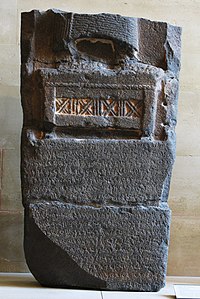Stele of Zakkur
| Stele of Zakkur | |
|---|---|
 The surviving part of the Stele of Zakkur with the inscription | |
| Material | Basalt |
| Height | 62 centimetres (24 in) |
| Width | 13 centimetres (5.1 in) |
| Writing | Aramaic inscription |
| Created | c. 805 – c. 775 |
| Period/culture | Aramaean |
| Discovered | 1903 |
| Place | Tell Afis, Syria |
| Present location | Musée du Louvre, Paris |
| Identification | AO 8185 |
The Stele of Zakkur (or Zakir) is a royal stele of King Zakkur of Hamath and Luhuti (or Lu'aš) in the province Nuhašše of Syria, who ruled around 785 BC.
The Stele was discovered in 1903 at Tell Afis (mentioned in the Stele as Hazrach),[1] 45 km southeast of Aleppo, in the territory of the ancient kingdom of Hamath.[2] It was published in 1907.[3] Its small part reads:
I am Zakkur, king of Hamath and Luash . . . Bar-Hadad, son of Hazael, king of Aram, united against me seventeen kings . . .all these kings laid siege to Hazrach . . . Baalshamayn said to me, "Do not be afraid! . . .I will save you from all [these kings who] have besieged you"[4]
'Bar-Hadad' mentioned in the inscription may have been Bar-Hadad II or Bar-Hadad III, son of Hazael.[5]
Two gods are mentioned in the inscription, Baalshamin and Iluwer. Iluwer was the personal god of king Zakkur, while Baalshamin was the god of the city. It is believed that Iluwer represents the earlier god Mer or Wer going back to 3rd millennium BC.
This inscription represents the earliest Aramaean evidence of the god Baalshamin/Ba'alsamayin.[6]
See also
Notes
- ^ Scott B. Noegel, The Zakkur Inscription. In: Mark W. Chavalas, ed. The Ancient Near East: Historical Sources in Translation. London: Blackwell (2006), 307-311.
- ^ Yildiz, Efrem "The Aramaic Language and Its Classification" Journal of Assyrian Academic Studies [1]
- ^ Gibson J.C.L., Textbook of Syrian Semitic Inscriptions II, Oxford 1975, num. 5.
- ^ As translated in Poobalan, Ivor "The Period of Jeroboam II with Special Reference to Amos" [2]
- ^ Scott B. Noegel, The Zakkur Inscription. In: Mark W. Chavalas, ed. The Ancient Near East: Historical Sources in Translation. London: Blackwell (2006), 307-311.
- ^ Herbert Niehr (ed), The Aramaeans in Ancient Syria. Handbook of Oriental Studies. Section 1: The Near and Middle East. BRILL, 2014 ISBN 9004229434
External links
- The Aramaic Inscription of Zakar, King of Hamath
- A picture of the stele online.
